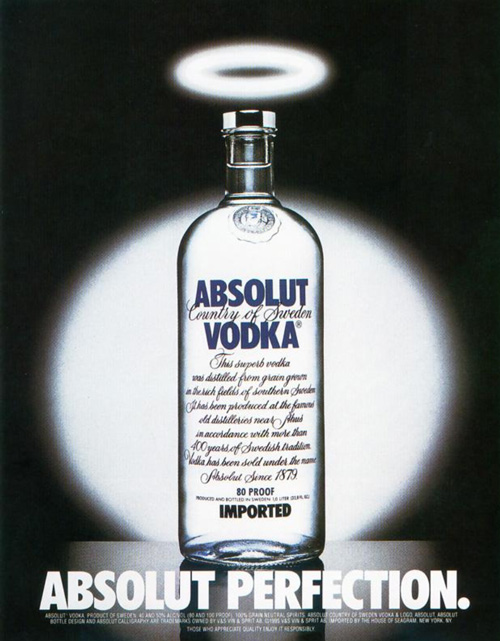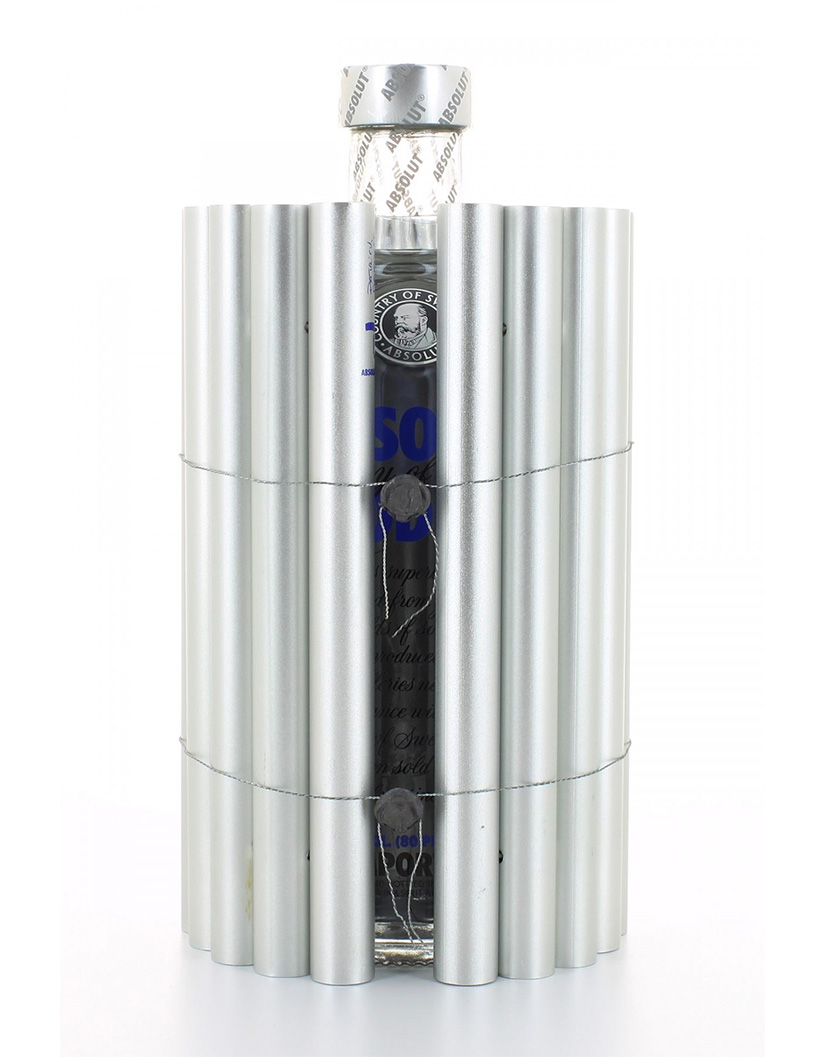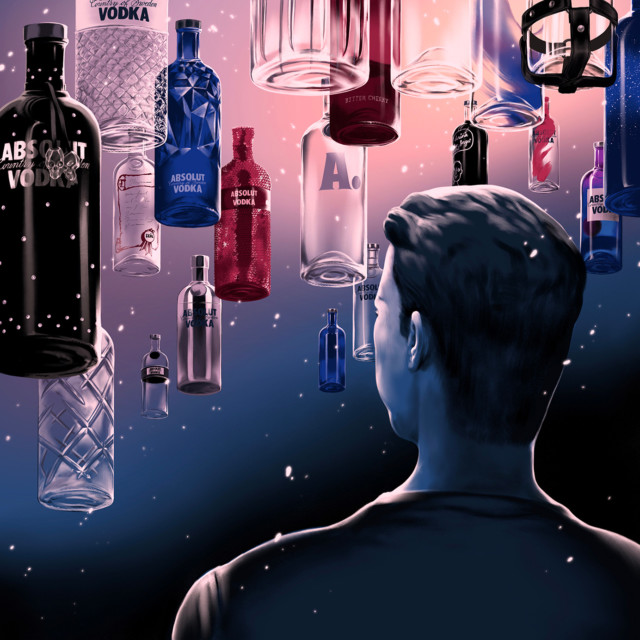Move-in day, freshman year, at Syracuse University’s Brewster-Boland dormitory and the quickest way to assess your new neighbors was via their wall decorations. There were the requisite “Pulp Fiction” and “Scarface” posters. The kids from Texas were always sure to hang giant Lone Star flags. But the most prevailing decorative choice in the late summer of 1997 was a series of colorful advertisements for a vodka brand we were all too young to legally purchase. Little did we 18-year-olds realize that we were in the midst of one of the greatest success stories in liquor advertising — one so potent it would eventually spawn collectors across the globe who still flourish today.
“Readers tear out the ads and hang them on their walls. Librarians have to guard their magazines from being de-Absoluted. College students actually collect and trade ads,” wrote Richard W. Lewis, then executive vice-president for ad agency TBWA Chiat/Day, in the introduction to his 1996 New York Times-bestselling book on the phenomenon. “Absolut Book: The Absolut Vodka Advertising Story,” offered over 250 pages of ads for this campaign that had started some 15 years earlier.
In 1980, New York City advertising agency TBWA was still fairly new (it wouldn’t merge with Chiat/Day until 1995) and had a goal of shaking up the industry by being “creative before creation.” When they won the Absolut Vodka account that year, the Swedish brand asked TBWA to position it as “smart, stylish, contemporary, creative, unexpected, witty, and of superior quality.” Though Absolut had been around since 1879, it now aspired to make a splash in the U.S. market.
Brown spirits were still slumping in this country and lighter, seemingly “cleaner” spirits like gin, tequila, and especially vodka had taken up the fold. The market was ultra-competitive, too; how could one odorless, flavorless spirit differentiate itself from another? With advertising, of course.
Gordon’s was “the happy vodka.” Wolfschmidt the vodka of czars. And Smirnoff had ads featuring people like future O.J. Simpson attorney, F. Lee Bailey, espousing that “There’s vodka, and then there’s Smirnoff.”
But Absolut didn’t want its new ads to feature any people, or identify or salute any sort of lifestyle or particular demographic. It simply wanted to show its unique bottle, which was based on an old Swedish apothecary bottle.
Heading up the account was TBWA adman Geoff Hayes, whose Don Draper-like epiphany would take place not at a hippie commune in California, but while watching an old episode of “The Honeymooners” in his Manhattan apartment. He quickly sketched a prototype for the ad, adding the tagline: “Absolut. It’s the perfect vodka.’”
“He realized that his client’s product was a now century-old creation of refined purity, and his ad needed to reflect this perfection,” Etienne Dale writes of Hayes, who died by suicide in 2006. The resulting print ad simply showed the Absolut bottle, spotlighted as if on a stage, a glowing halo above its head. The tagline at the bottom, slightly tweaked by Hayes’s copywriter partner Graham Turner, read, Absolut Perfection.

Over the next 30 years, thousands of similar ads would follow, Absolut would become the top vodka brand in America as many millions of bottles would be sold, and plenty of fanatics for the ads, the swag, and, eventually, the limited edition bottlings, would emerge.
“I think collectors are drawn to [Absolut] because we never know what new concepts they will come up with next,” says Jon McKeigue, an Absolut collector in Australia. “It’s always evolving.”
Absolut Unicorn
Régis Droandi’s Absolut fascination began in 1999, when he was just a teen living at home in Corsica. That year his parents returned from a holiday to Andorra and brought him a bottle of the standard Absolut Red Label. He was so young at the time that his favorite cocktail was vodka and apple juice. Nevertheless, he was immediately obsessed with the Swedish brand and began searching local stores for unique Absolut bottlings. Eventually, he wanted to meet others like him.
“When I realized a lot of collectors shared the same passion around the world, I decided to create a dedicated website, where we could all discuss our passion,” says Droandi. He launched Absolut Régisin 2008, the first international site dedicated to Absolut collectors. Eventually, there was also Absolutcollectorsworld, Absolutfans, and AbsolutAd, a site that looks like it was designed in the late 1990s, but nevertheless remains an invaluable resource for Absolut ad obsessives, tracking literally every one that has ever existed.
Though some of those sites have since gone defunct, 13 years after its launch, Absolut Régis still has a very active forum, with over 2,000 posters, and Droandi believes Absolut collecting is as hot as ever.
“It doesn’t decrease,” he claims. Today he has an entire room in his house fully dedicated to Absolut bottles. By some estimates, there are at least 5,000 other people across the globe just as hardcore as him. “Some old collectors quit collecting, and some new ones are just beginning,” he says.
Absolut claims the highest concentration of collectors today are in Central and South America, but most collectors I spoke with seem to be in Europe. In Germany, Kevin Klapper began collecting in 2007 thanks to the cheeky appeal of Absolut Disco, which came in a disco ball-themed casing made of 1,000 reflecting prisms. He had been a casual Absolut drinker with his buddies on weekends, but that was the first bottle he left sealed and unopened. The initial print campaign had just ended in 2006 and Absolut seemed to be focusing its marketing efforts on introducing new flavors and limited edition bottlings each year. This gambit would create even more obsessives.
“For me, Absolut Vodka was a unique brand which, every few months, created something special and desirable for thousands of collectors,” says Klapper, who began scouring supermarkets and airport duty frees across the globe as well as buying bottles off eBay, back when the auction site still allowed liquor sales.
Absolut Disco would likewise bring Karl Okon, an international accountant from Germany, into the fold, when he stumbled upon it hanging from a bar’s ceiling. Immediately entranced, he begged the owner to sell it to him and, when the man refused, Okon took to German collector forums to begin the hunt — he was “magically attracted” to Absolut and today has over 300 bottles.
“I could not even name any other (liquor) brand that is doing something similar,” he says.
For Antonio Abatangelo, a 38-year-old bar consultant and events manager in Italy, his Absolut passion began when he randomly stumbled upon the red-spangled Masquerade bottling in 2008. He had just started bartending and collecting Absolut bottles felt like a way to quickly become a part of drinking culture.
“I searched further and found a world I really wanted to explore,” he recalls. Droandi’s forum had just begun and Abatangelo became an active participant, all the while amassing more and more collectibles. “Every bottle has a story, they arrive from all corners of the globe, the art that embodies them is a small piece of culture of that country,” he says.
Like in Adelaide, where McKeigue, a patisserie chef lecturer originally from Boston, has been a “hybrid” collector since 1989. He has over 1,600 ads and 200 bottles stored between the two continents he calls home. (“It’s a problem,” he jokes.) Yet he can’t help himself from searching for rarer and rarer bottlings via social media and various trading pages online.
The brand’s frequent collaborations with hip designers (like Tom Ford and Stella McCartney) and cool artists (Andy Warhol and Keith Haring, among others) means there’s always new pieces of alcoholic art to pursue.
“One of the unicorns that I’ve been chasing is Absolut Gustafson,” McKeigue notes, referring to a 2012 duty-free bottle designed by noted Swedish watercolorist Mats Gustafson that was recalled mere days after its release. There is some discrepancy to that story, with Absolut claiming some people had an allergic reaction to the unusual cherry, strawberry, cardamom, and chai flavor; while other rumors abound that a copyright dispute between Gustafson and Absolut led to the recall. “We’ll never know, and now a Gustafson bottle is worth around $2,000 — if you can find it,” McKeigue says.
Yes, just like in the whiskey world where unicorn bottles fetch hundreds if not thousands of dollars, the same is true for some Absolut bottles. (And, yes, even if they mainly care about the packaging, collectors still want sealed bottles.)
Collectors today are consumed in their global search for bottlings, with ones like Glow, Midsommar, Pugh Mode, Freestyle, Akademi, and Visibility (a.k.a. Titania) garnering the most buzz. These may seem like nonsense words to most, but they’re ones that would make any serious Absolut collector’s eyes bulge.
(Almost all these collectors, upon finding out I was located in America, asked me to keep an eye out for certain bottlings.)
Droandi’s most prized scores include Absolut Tube, a 2003 release designed by French artist Patrick Daumont, limited to 200 bottles and only sold at two Parisian stores. And Absolut French Tack, a “thank you” bottle hand-painted by Swedish artist Astrid Sylwan and issued to 10 top sales managers at Pernod Ricard. Today it’s perhaps the holy grail among collectors.

Still, the most Droandi has ever paid for a bottle was for Absolut American, a 1992 release in the States, meant to celebrate the 500th anniversary of (cough) Columbus discovering the country, and limited to just 50 bottles. The hand-engraved crystal bottle depicts a Native American shaman woman surrounded by an eagle spirit as well as Marilyn Monroe, the NASA space shuttle, the Eye of Providence, and others.
“That’s, in my opinion, the most beautiful bottle ever created by Absolut,” says Droandi. When he finally stumbled upon it, he felt he had no choice but to drop the several thousand dollars it currently fetches. “The only time I’ve ever paid an indecent price,” the collector adds.
Absolut Flipper
Lest you doubt these folks and think the glory days of Absolut collecting must surely have ended back in the ’90s, that’s hardly the case. In fact, the market for these bottles just might be stronger than ever before. Fans began organizing an annual Absolut Collectors Meeting starting in 2010. The most recent one, due to Covid, was held in Åhus, Sweden, in May of 2019. The 200 available tickets sold out in less than an hour, with many hopeful attendees clamoring to get into the multi-day event (so much so that a second meeting had to be held). Collectors came to the small town from a reported 28 countries.
“Thanks to the ever-changing technology and social media coming into play, I think [the hobby] has grown exponentially as it has given us much more visibility at the same time,” says Abatangelo.
Just like the secondary market in whiskey, many Absolut collectors have, of course, begun to do their wheeling and dealing on Facebook, which has at least 20 different collecting groups. Okon hosts one such group, Absolut Feedback Corner, to help collectors avoid fraudulent and unscrupulous traders. Also just like the whiskey world, many Absolut collectors have grown annoyed with “flippers,” those who don’t truly have a passion for the hobby or even drink these vodkas, but simply snatch up rare bottlings to quickly flip for a profit.
“During the last few years we realized that many collectors stopped collecting, annoyed by some resellers who are basically selling everything for profit,” says Klapper.
Similarly, some collectors have grown bored with the brand, feeling like Absolut is releasing too many new bottles per year, making each one less significant. Klapper also feels like Absolut has never truly respected its collector community in the same way that, say, Nike or Swatch have, in intentionally creating coveted releases for them to get excited about. (Although, it must be said, Absolut does sponsor the convention.)
“But Absolut Vodka will always attract new people,” says Klapper. “With every new campaign Absolut is starting, new people will become fascinated about the brand and start drinking and collecting it.”
And for people like him now entering their third or even fourth decades as collectors, these people will likely never give up their pursuits. There are just too many bottles, too many skins, too many Absolut items to find that it’s virtually impossible for any one person to complete their collection.
As Droandi says, “I don’t have a top wanted bottle, any bottle I don’t have is a ‘top wanted’ for me.”
This story is a part of VP Pro, our free platform and newsletter for drinks industry professionals, covering wine, beer, liquor, and beyond. Sign up for VP Pro now!
